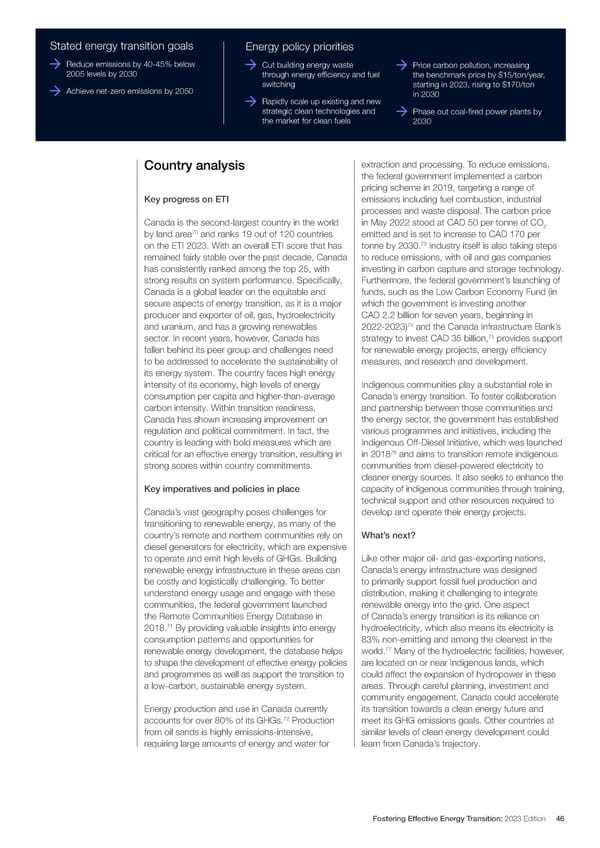Stated energy transition goals Energy policy priorities Reduce emissions by 40-45% below Cut building energy waste Price carbon pollution, increasing 2005 levels by 2030 through energy ef昀椀ciency and fuel the benchmark price by $15/ton/year, Achieve net-zero emissions by 2050 switching starting in 2023, rising to $170/ton Rapidly scale up existing and new in 2030 strategic clean technologies and Phase out coal-昀椀red power plants by the market for clean fuels 2030 extraction and processing. To reduce emissions, Country analysis the federal government implemented a carbon pricing scheme in 2019, targeting a range of Key progress on ETI emissions including fuel combustion, industrial processes and waste disposal. The carbon price Canada is the second-largest country in the world in May 2022 stood at CAD 50 per tonne of CO 2 by land area70 and ranks 19 out of 120 countries emitted and is set to increase to CAD 170 per on the ETI 2023. With an overall ETI score that has 73 Industry itself is also taking steps tonne by 2030. remained fairly stable over the past decade, Canada to reduce emissions, with oil and gas companies has consistently ranked among the top 25, with investing in carbon capture and storage technology. strong results on system performance. Speci昀椀cally, Furthermore, the federal government’s launching of Canada is a global leader on the equitable and funds, such as the Low Carbon Economy Fund (in secure aspects of energy transition, as it is a major which the government is investing another producer and exporter of oil, gas, hydroelectricity CAD 2.2 billion for seven years, beginning in 74 and the Canada Infrastructure Bank’s and uranium, and has a growing renewables 2022-2023) 75 sector. In recent years, however, Canada has strategy to invest CAD 35 billion, provides support fallen behind its peer group and challenges need for renewable energy projects, energy ef昀椀ciency to be addressed to accelerate the sustainability of measures, and research and development. its energy system. The country faces high energy intensity of its economy, high levels of energy Indigenous communities play a substantial role in consumption per capita and higher-than-average Canada’s energy transition. To foster collaboration carbon intensity. Within transition readiness, and partnership between those communities and Canada has shown increasing improvement on the energy sector, the government has established regulation and political commitment. In fact, the various programmes and initiatives, including the country is leading with bold measures which are Indigenous Off-Diesel Initiative, which was launched 76 and aims to transition remote indigenous critical for an effective energy transition, resulting in in 2018 strong scores within country commitments. communities from diesel-powered electricity to cleaner energy sources. It also seeks to enhance the Key imperatives and policies in place capacity of indigenous communities through training, technical support and other resources required to Canada’s vast geography poses challenges for develop and operate their energy projects. transitioning to renewable energy, as many of the country’s remote and northern communities rely on What’s next? diesel generators for electricity, which are expensive to operate and emit high levels of GHGs. Building Like other major oil- and gas-exporting nations, renewable energy infrastructure in these areas can Canada’s energy infrastructure was designed be costly and logistically challenging. To better to primarily support fossil fuel production and understand energy usage and engage with these distribution, making it challenging to integrate communities, the federal government launched renewable energy into the grid. One aspect the Remote Communities Energy Database in of Canada’s energy transition is its reliance on 71 By providing valuable insights into energy hydroelectricity, which also means its electricity is 2018. consumption patterns and opportunities for 83% non-emitting and among the cleanest in the renewable energy development, the database helps 77 Many of the hydroelectric facilities, however, world. to shape the development of effective energy policies are located on or near Indigenous lands, which and programmes as well as support the transition to could affect the expansion of hydropower in these a low-carbon, sustainable energy system. areas. Through careful planning, investment and community engagement, Canada could accelerate Energy production and use in Canada currently its transition towards a clean energy future and 72 accounts for over 80% of its GHGs. Production meet its GHG emissions goals. Other countries at from oil sands is highly emissions-intensive, similar levels of clean energy development could requiring large amounts of energy and water for learn from Canada’s trajectory. Fostering Effective Energy Transition: 2023 Edition 46
 Fostering Effective Energy Transition 2023 Page 45 Page 47
Fostering Effective Energy Transition 2023 Page 45 Page 47